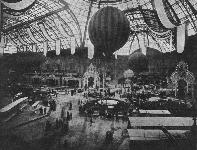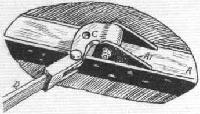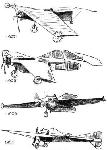В.Шавров История конструкций самолетов в СССР до 1938 г.
РЭП (РЕП) - сокращенное название самолета Робера Эно-Пельтри - французского ученого, конструктора и летчика. Самолеты РЭП были весьма своеобразны, особенно первый тип - 1909 г., приобретенный в конце 1910 г. в одном экземпляре для Гатчинской школы.
РЭП 1909 г. Самолет представлял собой одноместный среднеплан с обратным поперечным V крыла с двигателем РЭП в 35 л.с. Шасси велосипедного типа, заднее колесо малых размеров находилось под хвостовым оперением, на концах крыла были небольшие колеса, поддерживавшие самолет на земле (с большим креном). Переднее колесо имело масляно-воздушную амортизацию в стойке.
Самолет||РЕП 1909 г.
Год выпуска||1909
Двигатель, марка||РЕП
Мощность||35
Длина самолета, м||8
Размах крыла, м||11
Площадь крыла, м2||20
Полетная масса, кг||450
Удельная нагрузка на крыло, кг/м2||22,5
Удельная нагрузка на мощность, кг/лс||12,9
L.Opdyke French Aeroplanes Before the Great War (Schiffer)
Deleted by request of (c)Schiffer Publishing
REP
In 1904 Robert Esnault-Pelterie built a poor copy of the 1902 Wright glider from drawings and data published by Octave Chanute in an earlier issue of L'Aerophile; Chanute's figures and plan were in error, and Esnault-Pelterie compounded the errors. The pilot was slung underneath the rectangular wings on straps; a forward elevator and rear rudder were fitted; the wings may have warped on this first version. Control was to have been by weight-shifting in the sling.
The glider failed in May: the designer said the wing curvature was too great. In his lecture to the Aero-Club in Paris on 5 January 1905, later reprinted in L'Aerophile of June 1905, he stated that the glider had been an exact copy of the Wrights', and that therefore theirs had also failed and their reports were untrue. Esnault-Pelterie rebuilt the glider in October 1904; the span was reduced to 9.6 m. the wing curvature to 1:50, and the forward elevator removed: it is likely that this version incorporated wing-warping; but he quickly gave it up.
(Span: 10.2 m; wing curvature: 1:20 (Chanute gave this figure for the Wright glider, where it should have been 1:20 to 1:30)
He modified the glider again and flew it, still in October; this time 2 forward surfaces were set out ahead of the wings. They could move together as elevators and separately as ailerons. He outlined further tests, since attempts to fly this last version behind an automobile proved unsuccessful, but there were no further tests.
REP 1: In 1907 Esnault-Pelterie designed a new 30 hp 7-cylinder radial engine and his first powered aeroplane. Trapezoidal wings were set at an anhedral angle; the short fuselage had a triangular section and rounded top, with a long keel surface underneath; a triangular tailplane was mounted immediately aft of the trailing edges; a single wheel was fitted under the fuselage with large supporting wheels set on each side of the main wheel, and a small tailwheel; there was no vertical surface. The wings warped. It made several flights in November and December of 1907, the longest 600 m. A modification removed the 2 supporting wheels from under the fuselage and put them onto the wingtips.
(Span 9.6 m ; wing area: 18 sqm; 30 hp REP)
REP 2. In 1908 a long angular fin was added on top of the rear fuselage, and a long trailing rudder underneath; the tailplane was enlarged; hydraulic brakes were added, the first in history on an aeroplane. It was tested several times at Buc: on 8 June it managed a 1200-meter flight at a claimed speed of some 88 kmh, and a claimed altitude of some 30 m.
(Span 8.6 m; wing area: 17 sqm; weight: 350 kg; 30 hp REP)
REP 2bis: This 1909 design was similar to the REP 2, with reduced wing area (15.75 sqm). The tail fin was enlarged, the tailplane was removed, and the elevator placed further aft still. One was modified for the 1909 Reims race, with long trailing fin surface marked with the number 1. This in turn was altered again, with what became the typical REP triangular fin and rectangular rudder; a tiny semicircular rudder surface remained underneath.
Журнал Flight
Flight, January 9, 1909
THE FIRST PARIS AERONAUTICAL SALON.
"R.E.P. (No. 2)."
Monoplane constructed throughout at the R.E.P. works (Billancourt, Seine). The wings extend laterally from the forward end of a longitudinal steel girder of semicircular section, and are so made and mounted that they can be warped for the purposes of steering. The girder has fixed keels above and below; the latter terminates in a rudder, and behind the rudder is the elevator. In front is the engine, driving a 4-bladed tractor screw.
A feature of the construction is the covering of the entire machine with fabric, so as to present an unbroken surface. Also the top and bottom keels give an unusually large vertical area. Under ordinary conditions, the machine is controlled by a single pivoted lever, which operates the elevator and warps the wings. The rudder is operated by a separate lever working in a notched quadrant, and a third lever is used for setting the elevator at different normal angles.
Flight, February 20, 1909
M. Guffroy Flies on R.E.P. Machine.
ON Tuesday, after going through a couple of days' training at M. R. Esnault Pelterie's aerodrome at Buc, M. Maurice Guffroy, despite the mist, succeeded in making several short flights on the R.E.P. 2-bis monoplane, which he has entered for the Gordon-Bennet Cup. The longest flight measured nearly 70 metres. On Wednesday he was continuing his experiments, and succeeded in making a flight of 800 metres, which was brought prematurely to an end through an extraordinary accident. He failed when turning to quite clear a bank about 12 ft. high, and as a result of the collision the machine completely turned turtle. Marvellous to relate, as the monoplane was travelling at a speed of 80 kiloms. an hour, M. Guffroy escaped unhurt, and the only damage to the machine was a broken propeller.
Flight, March 27, 1909
FLYERS AT OLYMPIA.
Rep (BESSLER-WAECHTER).
The Rep monoplane exhibited by Messrs. Bessler-Waechter, who are the British manufacturers for M. Esnault-Pelterie, is in the main a copy of that No. 2 bis, which was exhibited at Paris and with which M. Pelterie has himself made his most successful experiments. Except in slight details which would pass unnoticed by those not closely acquainted with the precise lines of the earlier model, the flyer on view at Olympia is quite unaltered, but close inspection shows that the tail end of the body of the machine has been slightly modified in its lines and now is more rounded in its section than formerly. The rudder, too, is a little smaller, but the system of control remains unchanged. Ascending and descending is accomplished mainly by the use of the stern elevator, steering is managed by means of the rear rudder, and lateral stability is obtained by warping the main wings. These operations are performed by levers, one of which besides warping the wings also flexes the elevator within certain limits; this particular lever is universally jointed to move either sideways or to and fro. There are two other levers which can be used to set the rudder and to set the elevator in any given position. When ascending it is the rear edge of the stern elevator which is tilted; in biplanes which have an elevator in front of the machine it is of course the front edge which is tilted for this purpose. When proceeding at any given speed, an increase of speed of the engine also causes ascent with any given setting of the elevator.
A feature of the general scheme of the R.E.P. flyer is the mounting of the machine on two wheels, with guide wheels on the tips of the main wings, so that the pilot can learn to partially control his machine without leaving the ground. Why M. Esnault-Pelterie adopted the monoplane principle he explained in a lecture before the members of the Aero Club some weeks ago. It was, as our readers will remember, mainly because he found that the wires necessary in the construction of a biplane offered tremendous resistance, far greater in fact than would be imagined from their small diameter.
 |
L.Opdyke - French Aeroplanes Before the Great War /Schiffer/
|
The first REP, No 1, with the 2 supporting wheels moved out to the wingtips.
Short flights were accomplished by Robert Esnault-Peltrie in November and December 1907 in his first monoplane, powered by a 25hp engine also designed by him.
|
 |
L.Opdyke - French Aeroplanes Before the Great War /Schiffer/
|
| The REP No 2 of 1908, with changes as noted in the text.
|
 |
В.Шавров - История конструкций самолетов в СССР до 1938 г.
|
1909 Esnault-Pelterie REP 2 monoplane - similar to REP 1 (see 1908) but now with fin and rudder.
Flew up to 5 miles distance
Country of origin: France Designed and built by Robert Esnault-Pelterie
Span: 32'2"
|
 |
L.Opdyke - French Aeroplanes Before the Great War /Schiffer/
|
| One of the stages in the development of the REP No 2, the 2his, in a luckless moment.
|
 |
Журнал - Flight за 1909 г.
|
| "Mr. Guffroy's R.E.P. monoplane after its accident last week. When turning, during a flight of 800 metres at a speed of 80 kiloms. per hour, one of the wings struck the bank seen in the photograph, causing the machine to capsize and crash to earth in the position seen above. Only the propeller was damaged, and Mr. Guffroy escaped unhurt.
|
 |
Журнал - Flight за 1909 г.
|
| AERO SHOW AT OLYMPIA. - The Rep Monoplane, seen from above, and showing the lacing of the wing surfaces to the main frame; the lacing is subsequently covered with fabric. The elevator, tail, rudder and rigid keel are very distinctly shown.
|
 |
Журнал - Flight за 1909 г.
|
| ONE OF THE METHODS ADOPTED AT THE RHEIMS AVIATION MEETING FOR TAKING THE MACHINES UP TO THE STARTING LINE. - The monoplane in our picture being hauled along is one of the R.E.P. flyers.
|
 |
Jane's All The World Aircraft 1913 /Jane's/
|
| R.E.P. (1908). Early example of enclosed stream line body. Apparently the first machine in which steel construction appeared.
|
 |
A.Andrews - The Flying Maschine: Its Evolution through the Ages /Putnam/
|
| Before maturing as an outstanding theoretician of space flight (as early as 1912), Esnault-Pelterie had progressed from gliding to build some effective unconventional aircraft like this REP2 of 1908 - which, curiously, had no ailerons but used a primitive form of wing-warping.
|
 |
Журнал - Flight за 1909 г.
|
| PARIS AERO SALON. - General view of the principal part of the Aviation Section. In the foreground, a little to the left, is a back view of Ader's "Avion," to the right is the R.E.P. monoplane, and opposite to it is the Delagrange biplane. In mid-air is the "Ville de Bordeaux," and in the distance, down the Grande Nef, can be seen part of a spherical balloon.
|
 |
Журнал - Flight за 1909 г.
|
| PARIS FLIGHT SALON. - General view of the centre of the Grand Palais, showing the "Stands of Honour." In the middle, immediately under the spherical gas-bag, is the famous Bleriot cross-Channel machine. To its right is the "Rep" monoplane, in the extreme right foreground is the Farman biplane, to the left a French-made Wright flyer, and continuing round to the left the machines are respectively an Antoinette, a Voisin, and another Bleriot. The decorated spherical balloon in the distance is the Montgolfier.
|
 |
Журнал - Flight за 1910 г.
|
| On the R.E.P. monoplane the propeller forms a four-bladed tractor-screw in front.
|
 |
Журнал - Flight за 1909 г.
|
| R.E.P. N 2bis
|
 |
Журнал - Flight за 1909 г.
|
| Great care is taken in the construction of the Rep monoplane to cover every inch of the exterior with surface fabric. Its large keel down the middle of the back is a characteristic feature of this flyer.
|
 |
Журнал - Flight за 1909 г.
|
| A detail on the Rep monoplane.
|
 |
Журнал - Flight за 1911 г.
|
| The Development of the R.E.P. monoplane. 1907. Absence of top fin, inverted Vee. 1908. Vee still inverted, partial remedy by top fin. 1909. Inverted Vee very slight and larger top fin. 1910. Stable Vee, fin above centre diminished.
|

















